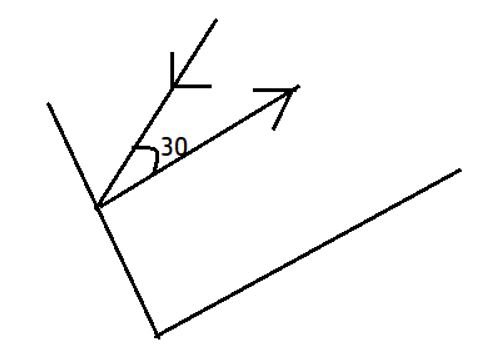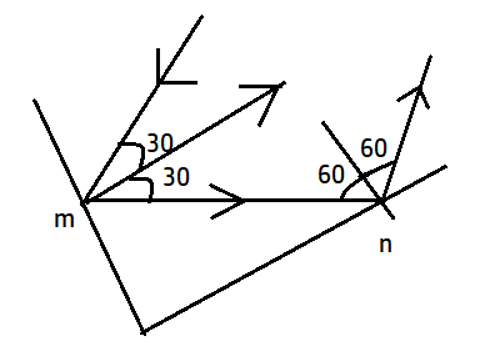
Two mirrors meet at right angles. A ray of light is incident on one at an angle of 30° as shown in Figure. Draw the reflected ray from the second mirror.


Answer
565.5k+ views
Hint: We are given plane mirrors and we know that light undergoes reflection at the surface of the plane mirror. The second law of reflection says the angle of incidence, the angle of reflection and the normal all lies at the same plane.
Complete Step by step answer:Now in order to solve the problem, we use the law of reflection. The light ray is incident at m and making an angle of \[{{30}^{0}}\], the law of reflection says, angle of incidence is equal to the angle of reflection. Now the rays go and strike the second mirror, the normal at m and the second mirror are perpendicular to each other. Using angle sum property for the triangle that would be made when we extend the normal at n to extend and touch the normal at m. The angle comes out to be \[{{60}^{0}}\].

Thus, it can be observed that the given ray of light will reflect from the second mirror at an angle \[{{60}^{0}}\]
Note: In reflection of light, there is bouncing back of light into the same medium.
Since the light travels in the same medium its speed does not change but in the case of refraction, there is a change of medium and hence such speed changes. Also, if the wave is an electromagnetic wave then its speed will not change as it travels with a constant speed. Light is also an electromagnetic wave and it falls in the visible spectrum of the electromagnetic spectrum.
Complete Step by step answer:Now in order to solve the problem, we use the law of reflection. The light ray is incident at m and making an angle of \[{{30}^{0}}\], the law of reflection says, angle of incidence is equal to the angle of reflection. Now the rays go and strike the second mirror, the normal at m and the second mirror are perpendicular to each other. Using angle sum property for the triangle that would be made when we extend the normal at n to extend and touch the normal at m. The angle comes out to be \[{{60}^{0}}\].

Thus, it can be observed that the given ray of light will reflect from the second mirror at an angle \[{{60}^{0}}\]
Note: In reflection of light, there is bouncing back of light into the same medium.
Since the light travels in the same medium its speed does not change but in the case of refraction, there is a change of medium and hence such speed changes. Also, if the wave is an electromagnetic wave then its speed will not change as it travels with a constant speed. Light is also an electromagnetic wave and it falls in the visible spectrum of the electromagnetic spectrum.
Recently Updated Pages
Master Class 10 General Knowledge: Engaging Questions & Answers for Success

Master Class 10 Computer Science: Engaging Questions & Answers for Success

Master Class 10 English: Engaging Questions & Answers for Success

Master Class 10 Social Science: Engaging Questions & Answers for Success

Master Class 10 Maths: Engaging Questions & Answers for Success

Master Class 10 Science: Engaging Questions & Answers for Success

Trending doubts
The shortest day of the year in India

Why is there a time difference of about 5 hours between class 10 social science CBSE

Write a letter to the principal requesting him to grant class 10 english CBSE

What is the median of the first 10 natural numbers class 10 maths CBSE

The Equation xxx + 2 is Satisfied when x is Equal to Class 10 Maths

State and prove converse of BPT Basic Proportionality class 10 maths CBSE




